This year marks the 60th anniversary of the milestones of economic, political and social freedoms for Bahamians that occurred in 1959, long promised under the Emancipation Act of 1833. University of The Bahamas faculty Dr Tracey Thompson and Dr Olivia Saunders mark the anniversary by exploring these shifts in an article entitled “Emancipation but not Freedom”. Dr Thompson directs “From Dat Time”: The Oral & Public History Institute. Dr Saunders teaches and writes on economics and economic history.
By Tracey Thompson & Olivia Saunders
University of The Bahamas
Slavery in The Bahamas brought with it so many “mustn’ts”. That is what the foundational work of Dr Gail Saunders, together with contributions from scholars like Ms Patrice Williams and Dr Howard Johnson who have built on that foundation, make plain.
Enslaved men and women found themselves intentionally hobbled by the laws that structured their enslavement. They must not move about freely. They must not gather among themselves on their own terms. They must not carry objects their rulers deemed to be dangerous weapons. They must not give evidence against a white person except in certain circumstances. They dare not speak threateningly to whites. Certainly they dare not involve themselves in seeking to change the social order. They must not involve themselves, either, in certain economic activities.
If they wanted to rake salt on their own account rather than under the aegis of a white manager, for instance, the salt would be taken from them, they were told, and the Crown would sell it and would keep the money. If they wanted to move through the community selling dry goods they must not – mainly because their vision and spunk would cut into the income of members of the merchant elite.
Limits such as these on their freedom of voice, action and initiative only grew as their numbers in the community rose. In their youthful years some of them might not have known they were subject to limits: the awareness might have come only over time. But if they lived long enough, the realities of having to squeeze themselves under whatever ceiling of aspiration a master or mistress dictated - and the frightening and bloody reprisals that awaited them if they stepped out of place - taught them bluntly how narrow was the space to which a rigid social order had consigned them.
What would likely have come into focus was the master class saw their power and potential, judged them to be a deep-seated threat and directed the force and advantage towards denying enslaved persons their humanity.
Those shackles were enough by themselves to make slavery chafe; but there was more to the tale than that telling. There was anxiety that ran alongside the risk of having one’s life uprooted.
By the time Emancipation came, for 40-odd years the cotton economy in the islands had been crumbling. What that meant was enslaved persons who were living as families – as many of them were doing – faced a very real prospect of being sold and so of being separated from one another. There was uncertainty in everyday life as well. Since the discretion of a master lay largely unfettered, enslaved men and women might face decency and kindness or, equally, negligence, viciousness and malice.
There was moral discomfort, surely. How else could intelligent minds and compassionate hearts respond to blatant, daily, unwarranted transfers of wealth from one group of people to another and to the brutality that kept such transfers in place?
Not everything was bleak, admittedly. With the reprieve that the fall of cotton had brought them, by the time Emancipation lay on the horizon enslaved men and women had been able to carve out for themselves lives of passing good health and of variety in the work they carried out. Some of them had been able to gain and practice skill in a wide range of trades. On plantations some of them were even placed by their absentee owners in charge of the undertaking.
But as a socioeconomic class they knew from raking salt how harsh and exhausting labour could be. They knew from cooking meals and washing clothes how much tedium and drudgery work could bring. They knew from keeping house in the master’s home how irksome could be ceaseless scrutiny. They knew what it was to work day in and day out – whether at feeding animals or ginning cotton or sawing timber or cutting stones or piloting boats or making shoes or dressing hair – only to have, at the end of the process, little or none of what they would have had if they had been free men and women.
In view of how dedicated to controlling their lives and exploiting their labour their masters proved themselves to be, what could they conclude but that a ruling class stood determined to grant them as little as possible and to extract from them as much as possible no matter, for those who were enslaved, the cost?
Emancipation pulled back some of the leeway which that master class had used to stop enslaved men and women from escaping their control, from developing their potential as human beings, and from coming into wealth and independence.
In August of 1833 Parliament in Britain, acting in its imperial capacity, passed landmark legislation. Part of the title of the legislation announced the promise that it offered to enslaved persons. The law declared itself to be, in part, “[a]n Act for the Abolition of Slavery throughout the British Colonies . . . .” It stated emphatically that in the following year its target population would become “free and discharged of and from all Manner of Slavery, and shall be absolutely and for ever manumitted”. It soon fulfilled that promise.
In most of the British Empire, at one stroke, on August 1, 1834, slavery expired as an institution sanctioned by law. What was more, as the Act looked ahead to apprenticeship as a framework which its colonies might choose to use on a temporary basis for structuring labour relations between former masters and formerly enslaved persons, it anticipated the potential for former masters and mistresses to abuse the framework and it explicitly put in place steps to forestall such abuse.
The year 1834 seemed to deliver from an intolerable structural predicament the 10,000-odd men, women and children in The Bahamas – rather more than half of them women and girls, and the great bulk of them born in the Americas rather than in Africa – who on the eve of Emancipation carried the status of ‘slave’.
How disappointing, then, for newly emancipated men and women in The Bahamas, that the impact of Emancipation upon their lives seemed to be far more ambiguous. To begin with, in contrast with legislators in some other colonies, Bahamian legislators did choose to use the apprenticeship system. What apprenticed Bahamian men and women found as a result was their lives were still enveloped in a system of supplying former masters with their labour or its cash equivalent on exploitative terms.
What was more, those who had the will and the means could still be required to pay former masters for their full release from bondage. What that looked like in practice, for instance, was that 81 Bahamian apprenticed men and women paid, in 1835, about 582 pounds sterling (£) for their emancipation – at today’s prices, some $2.6 million.
On the other side of the coin, former masters discovered a happy circumstance; and well did they know their good fortune. So pleased were they with the apprenticeship framework they asked the governor to prolong it past its expected ending date. What they liked, no doubt, was how it blunted any tendencies to turmoil the process of dismantling slavery might invite; how it allowed them to continue immorally to receive the fruit of others’ labour and others’ passion to be free; and how it hampered the flexibility of emancipated persons to move afield into swathes of unused land and build lives fully independent of their control.
Apprenticeship kept in place the subordination of former slaves and the power and privilege of former masters. As much as it sought to abolish slavery and to put in place, temporarily, a structure that would safeguard social stability, reward skills, and lend former slaves greater educational and religious exposure, what the Act achieved was to preserve unequal relations of power between men and women who had been masters and men and women who had been enslaved.
‘Keeping society stable’ was but another way of saying that economic and social practice should be interfered with as little as possible. That apprenticeship left in place deeply asymmetrical power relations was only, therefore, to be expected. What now enhanced still more the power of the master class were provisions that the Act proposed with respect to money.
In the legislation, the British government authorised its treasury to build a fund of up to £20 million – called the West India Compensation Account – to facilitate the aims of the Act. It was a huge commitment. It constituted fully 40 percent of Britain’s total public expenditure for that year. In today’s money, instructively enough, that sum would equal £336.7 billion.
But rather than handing freedmen and freedwomen that pot of gold, or at least a portion of it, to compensate them for decades of unpaid labour and to supply them with capital needed for them to launch successful agrarian, maritime, or other ventures, the legislation supplied freedmen with no relief at all. In utter contrast, monies were paid out, and handsomely so, to the class which had been elevated for so long. The reasoning was that masters and mistresses should receive compensation for losing the services of a people who generated their wealth, privilege and leisure.
The owners of Bahamian slaves were able to tap that legislative largesse. What they received, all told, was £126, 848.78 – today equivalent to £5,340,333,638.64. Such owners included Henry Greenslade, for example, who garnered £244.56 for his 13 slaves; James McKinney, who secured £419.28 for his 29 slaves; Sarah Poitier, who accepted £1,828.56 for her 152 slaves; and Henshall Stubbs, who collected an impressive £2,298.95 for his 192 slaves. Money buttressed the master class in using remaining laws to continue to constrain and coerce former slaves.
In The Bahamas, then, the impact of the Emancipation Act was to invigorate, not restrain, the ascendancy of a racialised economic and political elite. Looked at through the eyes of enslaved persons, the moment of Emancipation might well have seemed to be a sleight of hand. What had come, it appeared, was emancipation but not freedom.






Comments
Use the comment form below to begin a discussion about this content.
Sign in to comment
Or login with:
OpenID